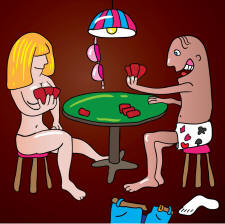Beating a Passive Player at Heads Up Poker
In order to win any given tournament, a player must defeat his opponent in a heads-up match. This heads-up match is very important when you look at the large gap in pay-outs between first and second place finishes. Considering this, you must allow yourself to adapt to your opponents style of play in order to control how the heads-up match runs. Having control of your opponent and playing against his style of play effectively should award you a first place finish, and a large first place cash prize.
Watch this Poker Video to Learn How to Beat Passive Players!
Passive players are a very unique type of player to play against in a heads-up match. These tight players can be played against in a specific way in order to give you a major advantage. Tight players tend to play far too passive in heads-up matches not realizing how valuable hands become when only two players sit at the table. Hands such as Ax, K10, Q9 and pocket pairs are much more valuable hands heads-up, but tight players may not play these hands.
Playing the Dealer Position
 When you sit in the dealer position, aggressive player will be much
more rewarded than that in the big blind. Playing aggressively against a
passive player will totally put your opponent into an uncomfortable
situation, exactly what tight players attempt to avoid. Putting constant
pressure from the dealer position will most likely cause your opponent
to fold.
When you sit in the dealer position, aggressive player will be much
more rewarded than that in the big blind. Playing aggressively against a
passive player will totally put your opponent into an uncomfortable
situation, exactly what tight players attempt to avoid. Putting constant
pressure from the dealer position will most likely cause your opponent
to fold.
Raising pre-flop with hands as low as Ax, K9, K10, Q9, and any pocket pair is common in any heads-up match. However against a more passive player than usual, you can continue to raise with hands even weaker than these. You can nearly put pressure (raise pre-flop) with any given hand. Although this may put you out of your comfort zone in which hands you normally raise with, your opponent will be even further discomforted. Making the bet around 3x the big blind will force a tight player to hold a strong hand in the big blind, and also give you position for the rest of the hand if you are called.
Continuation Bets
After making a pre-flop raise, a continuation bet may be very profitable against a tight player. A continuation bet is a bet on the flop that is made in hopes of taking down the pot, assuming that your hand has not improved. This bet can be very effective against a tight player, mainly because if your opponent did not improve his or her hand on the flop, he or she is likely to surrender on the flop.
Make this bet around half the pot or just under, this bet should not be a major portion of your stack, however it will look as if your hand is fairly strong and deter a tight player from continuing in the hand. If you have raised pre-flop with a hand such as A7 and were called by your opponent, consider this bet on the flop. If the flop came 2c 4c Kh, make this half-pot size bet. If your opponent held any decent hand such as QJ, Q10, Ax (the same as you), he will surely lay his hand down on the flop, awarding you the pot.
Your Stack vs. the Passive Player
The most advantageous position you can be in versus a tight player is in position with a dominating chip stack. You should use this position and chip stack to your advantage. If you have gotten to a 2 to 1 chip ratio, consider raising every single hand in dealer position in order to steal blinds and continue to place pressure on the short stack.
Tight players will most likely fold every hand until they have been dealt a hand strong enough to raise all-in in this position. Therefore your raises will continue to add to your stack, and when the player does in fact push back at you, you will have no problem laying down your hand.
Avoid Limping
One of the major plays to avoid in heads-up play against a tight player would be to simply limp in pre-flop. Tight players enjoy being able to see a cheap flop, and by limping this is exactly what you are doing. Continue to put pressure pre-flop until they play back at you. By putting pressure on them, they will continue to be hounded with tough decisions, which is exactly what causes players to go on tilt (read about avoiding poker tilt).
Now that you know how to beat a passive player heads up, learn how to beat an aggressive player heads up.
